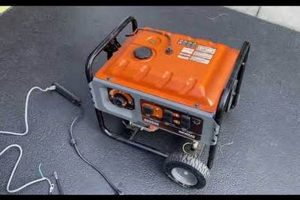Connecting a portable generator to the earth using a grounding rod and wire provides a path for stray electrical currents to dissipate safely. This protective measure prevents electrical shocks and equipment damage by ensuring that any unintended electrical flow is directed into the ground instead of through a person or sensitive electronics.
This practice significantly enhances safety during generator operation. It safeguards individuals from potentially lethal shocks, particularly in damp conditions or if a fault occurs within the generator or connected appliances. It also protects the generator and connected devices from damage caused by voltage surges and transient currents. Historically, the importance of grounding electrical systems has been recognized as the understanding of electricity and its associated hazards developed. Modern electrical codes and standards mandate grounding for safety and to mitigate potential risks.
The following sections will delve into the specifics of proper grounding procedures for portable generators, including the necessary materials, step-by-step instructions, and relevant safety precautions. Understanding and implementing these guidelines is crucial for safe and effective generator use.
Safe Grounding Practices for Portable Generators
Effective grounding is crucial for safe generator operation. The following tips outline essential procedures and precautions:
Tip 1: Consult Local Electrical Codes: Adherence to local electrical codes and regulations is paramount. These codes provide specific requirements for grounding procedures and materials, ensuring compliance with safety standards.
Tip 2: Select Appropriate Grounding Rod: Utilize a grounding rod specifically designed for electrical systems. Copper-clad steel rods are commonly used and offer excellent conductivity and corrosion resistance.
Tip 3: Ensure Proper Rod Installation: Drive the grounding rod firmly into the earth to a depth specified by local codes. Ensure the rod is in contact with moist soil for optimal conductivity.
Tip 4: Use Correct Gauge Wire: Employ appropriately sized copper grounding wire, again, as dictated by local codes. The wire should be thick enough to handle potential fault currents without overheating.
Tip 5: Secure Connections: Ensure all connections between the generator, grounding wire, and grounding rod are secure and tight. Use appropriate connectors and clamps designed for grounding applications.
Tip 6: Inspect Regularly: Periodically inspect the grounding system for damage or corrosion. Replace any worn or damaged components promptly to maintain system integrity.
Tip 7: Avoid Grounding to Plumbing: Never ground a generator to plumbing pipes or gas lines. This creates a serious safety hazard by potentially energizing these systems.
Tip 8: Consult a Qualified Electrician: If uncertainties arise regarding grounding procedures, consult a qualified electrician. Professional guidance ensures proper installation and adherence to safety regulations.
Adherence to these grounding practices significantly mitigates electrical hazards, protecting individuals and equipment from harm during generator operation.
By prioritizing proper grounding techniques, users can ensure the safe and effective utilization of portable generators in various applications.
1. Safety
Operating a portable generator safely requires a multifaceted approach, with grounding playing a critical role. A grounded generator significantly reduces the risk of electrical hazards, protecting both individuals and equipment. Understanding the connection between grounding and safety is essential for responsible generator use.
- Shock Prevention
Grounding provides a low-resistance path for fault currents to flow directly into the earth, preventing them from passing through individuals. This drastically reduces the risk of electric shock, a potentially fatal hazard, particularly in wet conditions or when handling metal objects. A grounded generator offers substantial protection by diverting stray currents away from users.
- Equipment Protection
Grounding safeguards connected appliances and the generator itself from damage caused by voltage surges and transient currents. These surges, often caused by lightning strikes or power grid fluctuations, can overload sensitive electronics. A properly grounded system diverts these surges into the earth, preventing costly repairs or replacements.
- Fire Hazard Reduction
Improper grounding can lead to overheating and potential fire hazards. Fault currents flowing through unintended paths can generate excessive heat in wiring and appliances. Grounding effectively minimizes this risk by providing a designated, low-resistance path for these currents, preventing dangerous temperature increases.
- Code Compliance
Electrical codes and standards mandate grounding for portable generators to ensure user safety and prevent accidents. Compliance with these regulations is not only legally required but also demonstrates a commitment to responsible generator operation. Adhering to these standards provides a framework for safe practices, minimizing risks and promoting overall electrical safety.
Grounding isn’t merely a recommended practice; it is a fundamental safety requirement for portable generator operation. By understanding the various facets of safety related to groundingshock prevention, equipment protection, fire hazard reduction, and code complianceusers can significantly reduce risks and ensure a safe operating environment. Neglecting grounding exposes individuals and equipment to unnecessary hazards, potentially leading to serious consequences. Prioritizing proper grounding demonstrates a commitment to safety and responsible generator use.
2. Shock Prevention
Electrical shock poses a significant hazard during generator operation. Grounding serves as a critical safety measure to prevent such incidents, protecting individuals from potentially lethal currents. Understanding the mechanisms by which grounding prevents shocks is paramount for safe generator use.
- Fault Current Path Diversion
A ground connection provides a low-resistance path for stray electrical currents, including fault currents. In the event of an insulation failure or other electrical malfunction within the generator or a connected appliance, the ground wire diverts the potentially dangerous current directly into the earth. This prevents the current from flowing through a person who may be in contact with the generator or connected equipment.
- Voltage Stabilization
Grounding helps stabilize voltage levels, preventing dangerous voltage spikes that can occur during generator operation. By providing a reference point for electrical potential, the ground connection helps maintain a safe voltage level, reducing the risk of shock. This is particularly important during transient events like lightning strikes or power surges.
- Wet Condition Safety
Moisture significantly increases the risk of electric shock. In damp environments or during rain, a grounded generator provides an essential layer of safety. Even a small amount of water can dramatically increase electrical conductivity, making a shock more likely. The ground connection ensures that any stray currents are safely diverted into the earth, even in wet conditions.
- Metal-Cased Appliance Protection
Many appliances, especially those used outdoors, have metal casings. If a fault occurs and the metal casing becomes energized, a grounded generator prevents the user from receiving a shock when touching the appliance. The ground connection ensures that the fault current is diverted to the earth, keeping the metal casing at a safe voltage potential.
These facets demonstrate the crucial role grounding plays in shock prevention during generator operation. Without a proper ground connection, individuals are at significant risk of electric shock, particularly under adverse conditions. Prioritizing grounding is essential for ensuring a safe operating environment and mitigating the potentially lethal consequences of electrical faults. By diverting fault currents, stabilizing voltage, ensuring safety in wet conditions, and protecting users from energized metal casings, grounding provides a fundamental layer of protection that is essential for responsible generator use.
3. Equipment Protection
Protecting valuable electronic equipment connected to a portable generator necessitates proper grounding. This practice safeguards against voltage spikes, surges, and fault currents that can damage or destroy sensitive electronics. The grounding system provides a low-resistance path for these stray currents to dissipate harmlessly into the earth, preventing them from flowing through connected devices. A grounded generator shields against damage caused by both internal generator faults and external electrical events, such as lightning strikes or utility grid instability. For instance, a sudden surge from a lightning strike near a power line can induce a high-voltage spike in the generator’s output, potentially frying connected electronics like computers or televisions. A proper ground connection diverts this surge into the earth, protecting the equipment.
The financial implications of equipment damage due to improper grounding can be substantial. Repairing or replacing sensitive electronics can be costly, and downtime due to damaged equipment can further impact productivity and finances. Grounding represents a small investment that offers significant protection against these potential losses. Furthermore, certain types of equipment, such as computers and other sensitive electronics, are particularly vulnerable to damage from voltage fluctuations. The grounding system acts as a buffer, shielding these devices from potentially harmful electrical events and ensuring their continued operation.
In summary, grounding offers crucial protection for equipment connected to portable generators. By providing a low-resistance path for fault currents and voltage surges, grounding mitigates the risk of damage to sensitive electronics, prevents costly repairs and downtime, and safeguards valuable investments. Implementing a proper grounding system is a proactive measure that ensures the longevity and reliable operation of connected devices, ultimately providing peace of mind and protecting against financial loss due to equipment damage.
4. Code Compliance
Adherence to established electrical codes is paramount when operating a portable generator. These codes mandate grounding as a critical safety measure, underscoring the direct link between code compliance and the necessity of grounding. Regulations such as the National Electrical Code (NEC) in the United States provide specific guidelines for grounding procedures, materials, and configurations. Ignoring these codes not only creates significant safety hazards but also carries potential legal ramifications. For example, NEC Article 250 outlines grounding requirements for generators and associated electrical systems, specifying appropriate wire sizes, grounding electrode types, and connection methods. These requirements are designed to minimize risks and ensure a safe operating environment. Failure to comply with these codes can result in fines, legal liabilities, and invalidation of insurance coverage in case of accidents.
Code compliance goes beyond mere legal obligation; it represents a commitment to safety and best practices. Electrical codes are developed based on extensive research, testing, and analysis of electrical hazards. They reflect a collective understanding of safe electrical practices, incorporating lessons learned from past incidents and advancements in electrical safety technology. For instance, specific requirements for grounding electrode conductor sizes and materials ensure the system can effectively handle fault currents, preventing overheating and potential fires. These codes evolve to address emerging technologies and enhance safety standards, providing a reliable framework for safe generator operation. Regularly reviewing and updating grounding practices based on the latest code revisions is crucial for maintaining a safe and compliant installation.
In conclusion, grounding a portable generator is not merely a suggestion; it is a requirement mandated by electrical codes. Compliance with these codes ensures the safety of individuals and equipment, minimizes legal liabilities, and reflects a commitment to responsible generator operation. Understanding and adhering to these regulations is paramount for mitigating electrical hazards and establishing a safe operating environment. Ignoring code requirements not only compromises safety but can also lead to legal and financial repercussions. By prioritizing code compliance, generator users demonstrate a commitment to best practices, ensuring the safe and effective use of this valuable power source.
5. Damage Mitigation
Damage mitigation represents a core benefit of proper generator grounding. Electrical systems, including portable generators, are susceptible to various events that can cause significant damage. These include voltage surges caused by lightning strikes, utility grid switching, or even internal generator faults. Grounding provides a low-impedance path for these transient currents, diverting them away from sensitive electronic equipment and preventing costly repairs or replacements. For example, a lightning strike near a power line can induce a surge that travels through the electrical system. In a grounded generator, this surge is safely channeled into the earth, protecting connected devices such as computers, televisions, and appliances. Without a proper ground, this surge could overwhelm the connected equipment’s protective circuits, leading to component failure and potentially irreparable damage.
The importance of damage mitigation extends beyond individual appliances to the generator itself. Internal faults within the generator can generate high currents that damage windings, control boards, and other components. Grounding effectively channels these fault currents away from the generator’s internal circuitry, minimizing internal damage and extending the generator’s lifespan. For instance, a short circuit within the generator windings can create a large current flow. A proper ground diverts this current, reducing the risk of overheating and potential fire hazards, thus protecting both the generator and its surroundings. This proactive approach to damage prevention saves on repair costs and minimizes downtime caused by equipment failure. The cost of repairing or replacing a generator often far exceeds the cost of implementing a proper grounding system, making grounding a financially sound practice.
In conclusion, grounding plays an indispensable role in damage mitigation for both connected equipment and the generator itself. By providing a safe pathway for transient currents and internal fault currents, grounding protects against costly repairs, extends equipment lifespan, and minimizes downtime. This proactive approach safeguards investments in electronic devices and ensures the reliable operation of the generator, making grounding a critical aspect of responsible generator ownership and a financially prudent measure. The relatively small investment in proper grounding materials and installation significantly outweighs the potential costs associated with equipment damage or replacement, providing long-term protection and peace of mind.
Frequently Asked Questions About Generator Grounding
Proper grounding is crucial for safe and effective generator operation. This FAQ section addresses common questions and concerns regarding this essential safety practice.
Question 1: Is grounding always necessary for portable generators?
Grounding is crucial for safety and is often mandated by electrical codes. It protects against shock hazards and equipment damage, especially in wet conditions or during faults.
Question 2: What type of grounding rod is recommended?
Copper-clad steel rods are commonly used due to their excellent conductivity and corrosion resistance. Local electrical codes may specify required rod length and diameter.
Question 3: Can a generator be grounded to a plumbing pipe?
Grounding to plumbing is extremely dangerous and should never be done. It can energize the plumbing system, creating a severe shock hazard.
Question 4: What size grounding wire is appropriate?
Wire size depends on the generator’s capacity and local electrical codes. Using undersized wire can lead to overheating and system failure. Consult the generator’s documentation and local codes for specific requirements.
Question 5: How often should the grounding system be inspected?
Regular inspection is essential. Check connections for tightness and corrosion, and examine the grounding rod for damage. Replace any compromised components promptly.
Question 6: What should be done if unsure about grounding procedures?
Consulting a qualified electrician is strongly recommended when uncertainties arise. Professional guidance ensures proper installation and compliance with safety standards.
Ensuring proper grounding is a fundamental aspect of generator safety. Understanding these frequently asked questions helps ensure safe and effective generator operation while mitigating potential hazards.
The subsequent section provides a step-by-step guide for correctly grounding a portable generator, offering practical instructions for implementing these essential safety measures.
Grounding Portable Generators
Safe and effective portable generator operation hinges on proper grounding. This practice mitigates significant risks, including potentially fatal electrical shocks, equipment damage, and fire hazards. Grounding provides a low-resistance path for fault currents, diverting potentially harmful electrical energy into the earth. This protection extends to both individuals interacting with the generator and connected devices, safeguarding against voltage surges and transient currents. Furthermore, adherence to established electrical codes, which mandate grounding, ensures legal compliance and reflects a commitment to industry best practices. Neglecting this critical safety measure exposes users and equipment to avoidable hazards, potentially resulting in severe consequences.
Prioritizing proper grounding procedures is paramount for responsible generator use. Thorough understanding of these procedures, combined with regular system inspection and adherence to established electrical codes, ensures safe and reliable generator operation. Investing time and resources in proper grounding ultimately protects lives, safeguards valuable equipment, and ensures the continued utility of portable generators in various applications. Electrical safety is not a matter of convenience but a fundamental necessity. Embracing proper grounding practices underscores a commitment to safety, mitigates potential risks, and fosters a secure operating environment for all.






